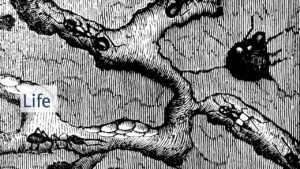Learning from nature, exploring life and emergence
“Throughout the living world, the creativity of life expresses itself through the process of emergence” – Fritjof Capra
Emergence is a peculiar phenomenon observed everywhere in nature. It happens when simple interactions among agents in a network give birth to a higher level, novel and complex structure, organisation or behaviour. When the whole becomes not only greater than the sum of its parts, but something completely new.
 Emergence is also the spontaneous creation of order at critical points of instability.
Emergence is also the spontaneous creation of order at critical points of instability.
In human systems we can think of the internet. From simple intercommunicating nodes we have the emergence of complex structures and behaviours on top of them. A technical solution that began as a resilient data communications network now hosts a web of user-readable information, marketplaces, and shop fronts for public and private organisations.
Human organisations always contain both designed and emergent structures. The designed structures are the formal structures of the organisation. The emergent structures are created by the organisation’s informal networks and communities of practice.
Designed structures provide the rules and routines that are necessary for effective functioning. They provide stability.
Emergent structures, on the other hand, provide novelty, creativity, and flexibility. Emergent structures are adaptive, capable of changing and evolving. In today’s complex organisational environment, purely designed structures do not have the necessary responsiveness and learning capability.
What can companies learn from emergent phenomena in nature and what insights can it provide for the businesses of the future?
We’ll explore this question with interviews with experts from Imperial from different fields, with conflicting concepts of the value of this natural phenomena for businesses.
Death of technologies
“Some technologies are so blatantly obnoxious that the human race would rejoice if they were obliterated.” – Bruce Sterling
 Technologies usually need a long time to be adopted and become mainstream. Once they do, they have the power of embedding themselves into the fabric of society, the industry and the habits and imagination of people. Certain technologies alter the fundamental way of human living, to the point where there is no going back. It seems impossible to conceive our life without them.
Technologies usually need a long time to be adopted and become mainstream. Once they do, they have the power of embedding themselves into the fabric of society, the industry and the habits and imagination of people. Certain technologies alter the fundamental way of human living, to the point where there is no going back. It seems impossible to conceive our life without them.
When so much infrastructure and many businesses are built around a technology and are powered by it, change is slow. There is reluctance in transforming infrastructure and businesses to welcome new solutions. There is fear around what will be displaced, and costs already sunk into pre-existing solutions.
An immediate example are combustion engines or plastic materials. Even though we’ve known for decades about the environmental damages that their use produces, substituting them is a painstakingly slow process.
“The gale of creative destruction is the process of industrial mutation that continuously revolutionizes the economic structure from within, incessantly destroying the old one, incessantly creating a new one” – Joseph Schumpeter
Transitioning to new technologies
“A new sustainable solution must be more attractive than the one that it is replacing.” – Tony Fadell
Recently, an Imperial College London startup won the £1 million Earthshot prize. Notpla have developed a seaweed-based packaging technology that can be used as an alternative to single-use plastics, especially in the hospitality and catering sectors.
Should transitions to such alternatives be forced by government interventions, philanthropic initiatives, or left to market forces? Usually, until scaling is cost-effective, companies don’t embrace novel solutions, and that’s where governments can come in with incentives and regulations.
Debating the future of technologies
What are the technologies of today that we should “kill off” to allow for new ones to replace them? What are the costs and how could we facilitate this transition?
These will be the questions surrounding our series of roundtables with Imperial Business Partners members and Imperial’s academic experts for Nature Meets Future. Here we will discuss possible frameworks of technological death: what we missed, what is in progress, what is needed; but also, what might be displaced from the pre-existing world and the issues surrounding that.
In a future that demands a substantial shift from profit-based and exploitative business models towards sustainable economic, social and ecological paradigms, facilitating technological death might be one of the key aspects to accelerate this transition.
Are you intrigued?
Understanding how patterns of life can be leveraged for the benefit of businesses means having an edge when strategizing for the future. Planning for death in technology is also key to sustain change and novelty, towards a world that is better for all.
About Imperial Tech Foresight 2042
Life and Death is a theme within Imperial Tech Foresight 2042 (ITF 2042) Nature meets future. ITF 2042 is produced as part of the Imperial Business Partners 20+ plausible futures programme. You can learn more about Imperial Business Partners here and more about the 20+ futures programme at Imperial Tech Foresight here.
Before you go…
While Imperial Tech Foresight produce content about the far future the Imperial Business Partners team connect their clients to Imperial experts from areas like..